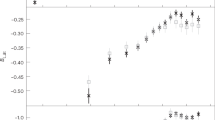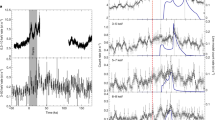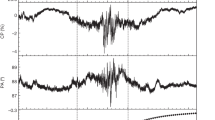Abstract
REES1 has discussed the appearance of relativistically expanding objects as seen by distant observers, with a view to explaining the variation of flux from radio sources. There he considers a spherical shell expanding with a uniform radial velocity v∼c. The apparent radius of the source at time t0, measured from the moment when the expansion is seen to begin, is γvt0, where γ = (1 − v2/c2)−1/2 The Doppler blue-shift, measured as the ratio of frequency observed to frequency emitted, varies from γ on the limb to γ[1 + v/c] in the centre. The effect of special relativity in Rees's model is to cut down the apparent time scales, in the cases where γv is greater than c. The actual variation of flux is obtained from an astrophysical model. Such a model might work for radio variations, but not for optical variations of quasi-stellar sources.
This is a preview of subscription content, access via your institution
Access options
Subscribe to this journal
Receive 51 print issues and online access
$199.00 per year
only $3.90 per issue
Buy this article
- Purchase on Springer Link
- Instant access to full article PDF
Prices may be subject to local taxes which are calculated during checkout
Similar content being viewed by others
References
Rees, M. J., Nature, 211, 468 (1966).
Author information
Authors and Affiliations
Rights and permissions
About this article
Cite this article
NARLIKAR, J. Role of Acceleration in Relativistically Expanding Objects and its Significance for the Intensity Variations in Quasi-stellar Sources. Nature 212, 1337–1338 (1966). https://doi.org/10.1038/2121337a0
Received:
Issue Date:
DOI: https://doi.org/10.1038/2121337a0
Comments
By submitting a comment you agree to abide by our Terms and Community Guidelines. If you find something abusive or that does not comply with our terms or guidelines please flag it as inappropriate.



